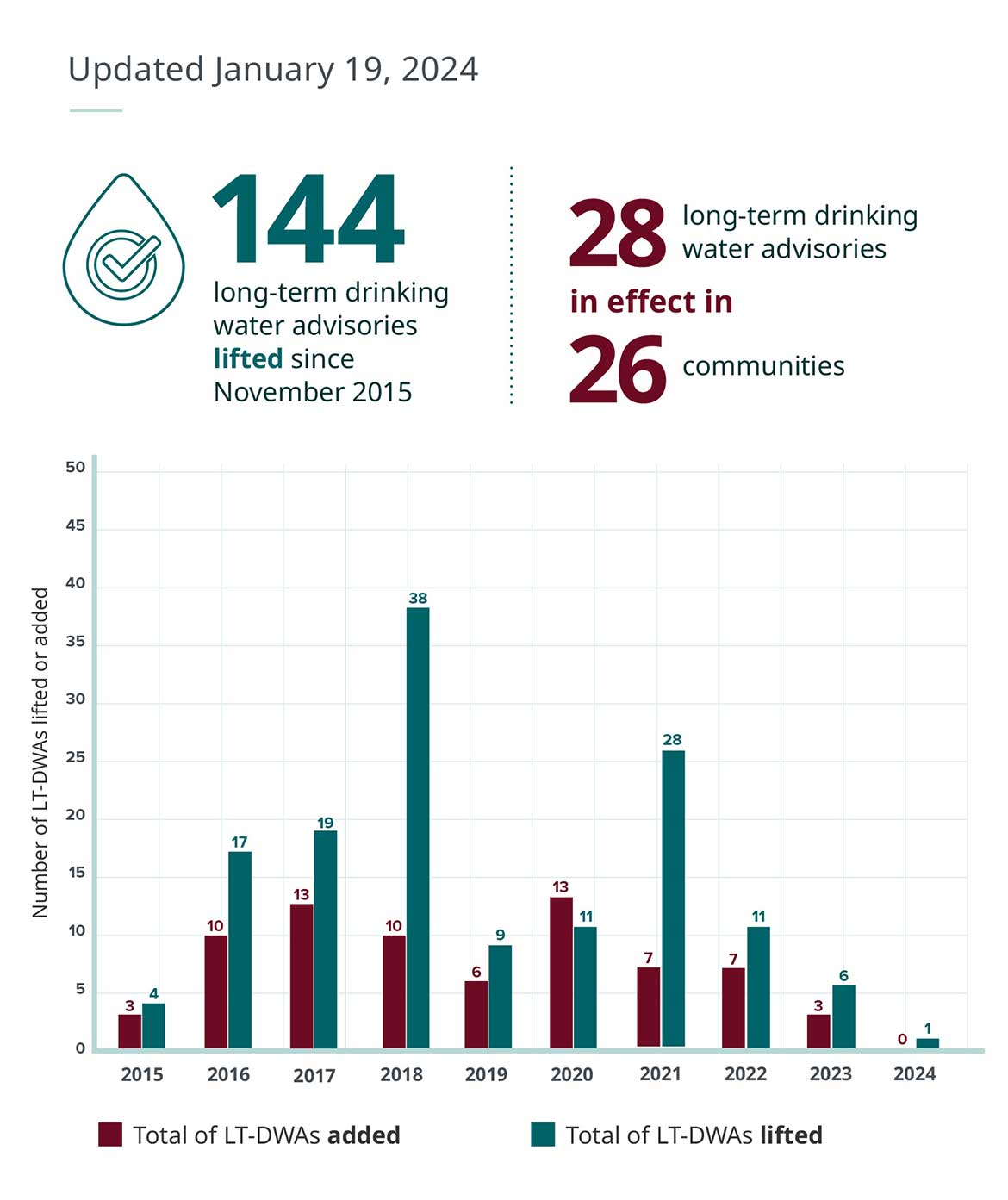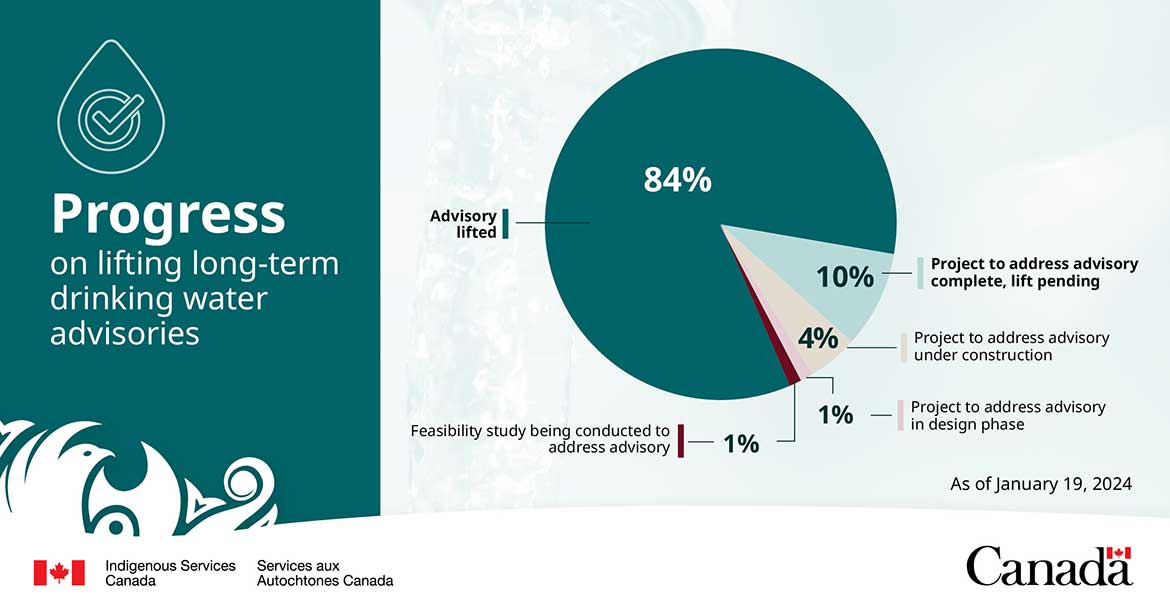Ending long-term drinking water advisories

Everyone in Canada should have access to safe, clean drinking water. The Government of Canada is working with First Nations communities to achieve clean drinking water on reserves.
Explore
Latest news
Recently lifted long-term drinking water advisories
English River First Nation as of November 7, 2024
English River First Nation in Saskatchewan lifted the drinking water advisory on their public water system on November 7, 2024. Upgrades to the water treatment plant were completed in September 2024. A new water operator was hired and is now keeping the community's water safe.
Fort Severn First Nation as of October 9, 2024
Fort Severn First Nation in Ontario lifted the drinking water advisory on their public water system on October 9, 2024, after completing upgrades to their water treatment system and training their water operators on the new equipment.
Recently added long-term drinking water advisories
Cat Lake First Nation as of March 11, 2025
The drinking water advisory affecting Cat Lake First Nation in Ontario became long-term on March 11, 2025 as it has been in effect for more than 12 months. The advisory affects 1 community building. The community completed upgrades to the water treatment system and are developing an action plan to address operational challenges. Once resolved, the community should be able to lift the advisory.
Munsee-Delaware Nation as of February 27, 2025
The drinking water advisory affecting Munsee-Delaware Nation in Ontario became long-term on February 27, 2025 as it has been in effect for more than 12 months. The advisory affects 46 homes and 1 community building. The community completed repairs to their water treatment system, and are developing an action plan to address new issues with water quality. Once resolved and water sampling is complete, the community should be able to lift the advisory.
Pikangikum First Nation as of February 8, 2025
The drinking water advisory affecting Pikangikum First Nation, in Ontario, became long-term on February 8, 2025, as it has been in effect for more than 12 months. The advisory affects 20 homes and 36 community buildings. The community has developed a plan to repair the water treatment system. Once repairs are done and water sampling complete, the community should be able to lift the advisory.
Rainy River First Nations as of February 6, 2025
The drinking water advisory affecting Rainy River First Nations in Ontario became long-term on February 6, 2025, as it has been in effect for more than 12 months. The advisory affects 107 homes and 5 community buildings. The community is upgrading and expanding their water treatment system. In the short-term, the community has access to clean drinking water through truck delivery.
Long-term drinking water advisories on public systems on reserves as of March 11, 2025

Text alternative for: Long-term drinking water advisories on public systems on reserves as of March 11, 2025
147 long-term drinking water advisories lifted since November 2015.
35 long-term drinking water advisories are in effect in 33 communities.
- 2025: 4 long-term drinking water advisories added and 0 lifted
- 2024: 6 long-term drinking water advisories added and 4 lifted
- 2023: 3 long-term drinking water advisories added and 6 lifted
- 2022: 7 long-term drinking water advisories added and 11 lifted
- 2021: 7 long-term drinking water advisories added and 28 lifted
- 2020: 13 long-term drinking water advisories added and 11 lifted
- 2019: 6 long-term drinking water advisories added and 9 lifted
- 2018: 10 long-term drinking water advisories added and 38 lifted
- 2017: 13 long-term drinking water advisories added and 19 lifted
- 2016: 10 long-term drinking water advisories added and 17 lifted
- 2015: 3 long-term drinking water advisories added and 4 lifted
Progress on lifting long-term drinking water advisories on public systems on reserves as of March 11, 2025

Text alternative for: Progress on lifting long-term drinking water advisories on public systems on reserves as of March 11, 2025
- 81% advisory lifted
- 9% project to address advisory complete, lift pending
- 8% project to address advisory under construction
- 1% project to address advisory in design phase
- 1% feasibility study being conducted to address advisory
Ensuring sustainable access to safe drinking water
Ending a long-term drinking water advisory is a complex process and requires collaboration between First Nations communities and the Government of Canada. Actions to resolve a water or wastewater issue can include:
- feasibility studies
- new system design work
- interim repairs on existing systems
- permanent repairs to existing infrastructure
- construction of new infrastructure
- improved training and monitoring
Initiatives are underway in each community to address the active long-term drinking water advisories. The decision to lift a long-term drinking water advisory lies with a community's chief and council, based on recommendations from environmental public health officers.
There are different types of drinking water advisories in First Nations communities. To learn more about why and when they are issued, visit About drinking water advisories.
Eliminating long-term drinking water advisories is just 1 part of ensuring First Nations communities have reliable access to safe drinking water:
- Investing in water and wastewater infrastructure
- Keeping water systems running and properly staffed
- Supporting First Nations' control of water delivery
The timeline of every water and wastewater infrastructure project differs. For example, completion of a new water treatment system can take 3 to 4 years to complete. See the Life-cycle of a First Nations community infrastructure project.
In addition to resolving long-term drinking water advisories, work is also underway to support community infrastructure projects on reserve to build a sustainable foundation and increase reliable access to clean drinking water for generations to come.